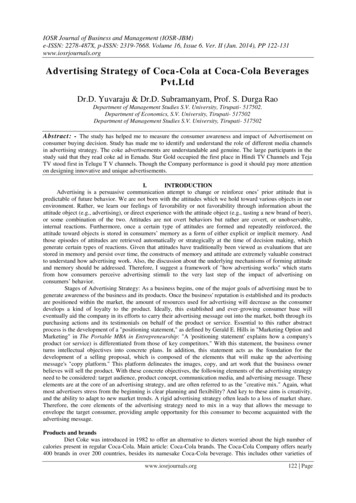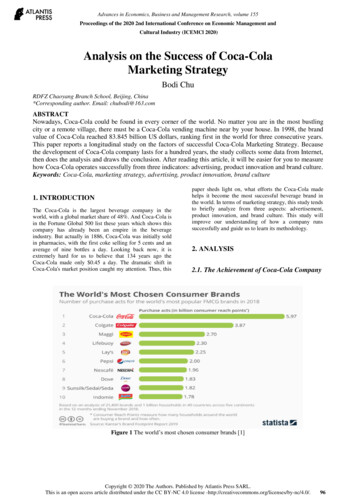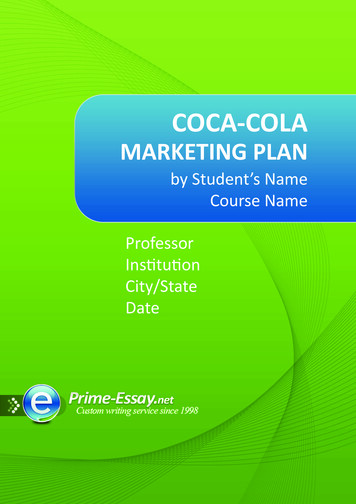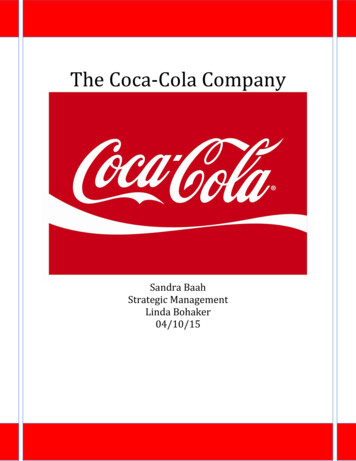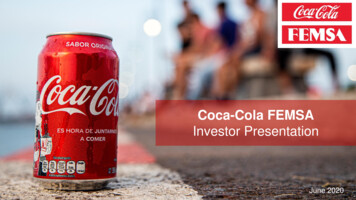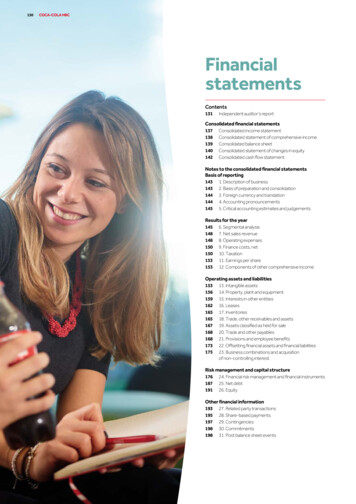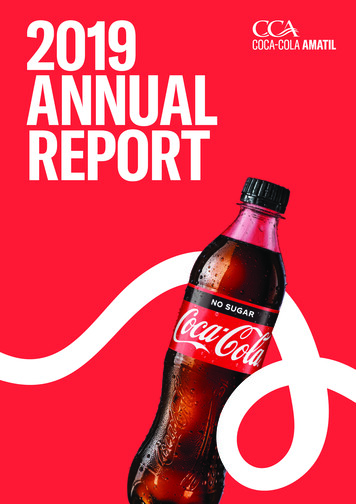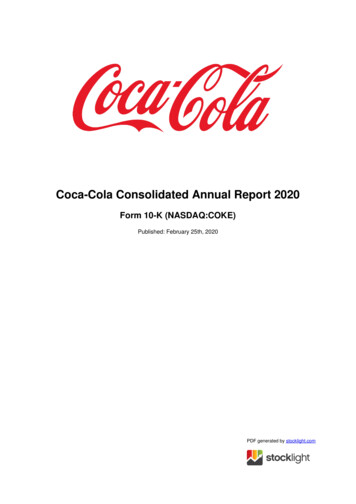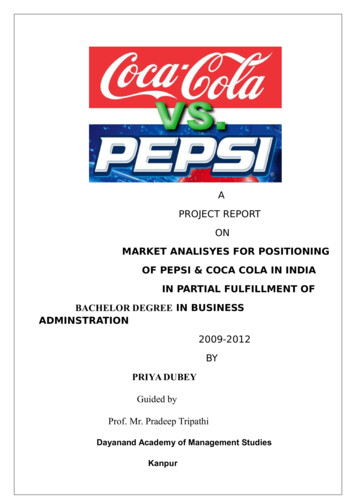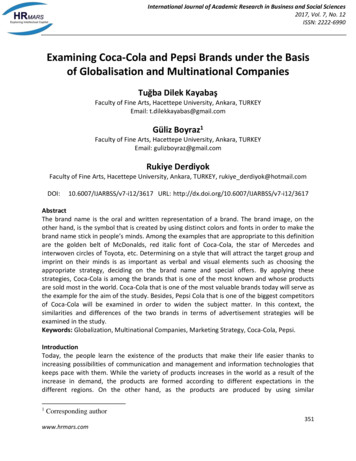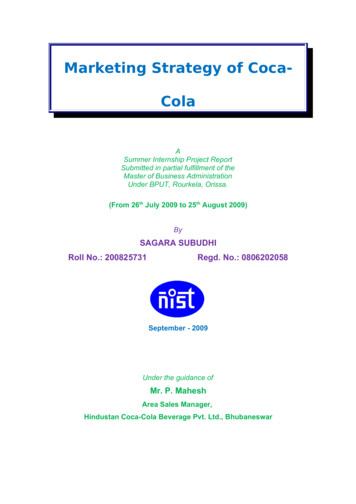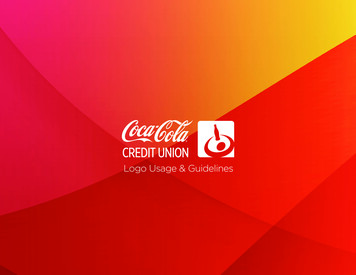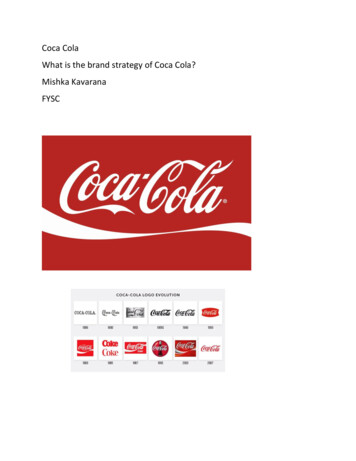
Transcription
Coca ColaWhat is the brand strategy of Coca Cola?Mishka KavaranaFYSC
What is the brand strategy of Coca Cola?The reason I chose this topic is because the brand Coca Cola has certain strategies which shows in their sales.Despite having grown into a massive global industry with innumerable products, Coca-Cola has never strayed fromits timeless and basic ideals. Throughout the decades and multitudes of marketing campaigns, Coca-Cola hasremained consistent when communicating one strong and effective message: pleasure. Enduring, simple sloganssuch as “Enjoy” and “Happiness” never go out of style and translate easily across the globe. Despite its status as aglobal icon, Coca-Cola understands that it has to find a way to speak to consumers at a more personal, localizedlevel. A significant part of Coca-Cola’s success is its emphasis on brand over product. Coke doesn’t sell a drink in abottle, it sells “happiness” in a bottle. With thousands of different products and packaging designs that vary amongregions, a global marketing plan focused on the products themselves would be challenging to manage. Instead,Coke aims to sell consumers the experience and lifestyle associated with its brand. Making human connections,remaining innovative while staying true to simple principles, and creating branded experiences are all globalmarketing techniques that have contributed to Coca-Cola’s place as an industry leader, even after 125 years.Coca Cola doesn’t target a specific segment but adapt its marketing strategy by developing new products.Segmentation enables brands to define the appropriate products for different kind of customers. Generally, Cokedoes not have a specific target and is addressed to everyone. But the main consumers are 12-30 years old people;even if there is no specific product or communication for less than 12 or more than 30, the brand succeed inreaching them, through partnerships for example restaurants, fast foods such as McDonald’s or thanks to its valueamong consumers. So, the core target audience of Coca Cola is youngster or youth. Their targeting is not based ongender but the results show that both genders like this product and use it almost 50/50. Finally, Coca Cola considereach customer as a target and a potential consumer. All age groups are being targeted but the most potential isthe age group from 18-25 that covers around 40% of total age segments. The brand has no lifestyle targeted butmore and more busy lifestyle and mobile generation (youth) are considered to be the most important part ofCoke’s consumers. It has no occupation targeted but consumers are mainly students and family oriented people.
The long-time rival soft drink producers The Coca-Cola Company and PepsiCo have engaged mutually- targetedmarketing campaigns for the direct competition between each company's product lines, especially their flagshipcolas, Coca-Cola and Pepsi. Beginning in the late 1970s and into the 1980s, the intensity of these campaigns has ledto them, and the competition in general, being known as the cola wars. Pepsi is sweeter than Coke, so right away ithad a big advantage in a sip test. Pepsi is also characterized by a citrusy flavor burst, unlike the more raisin-vanillataste of Coke. But that burst tends to dissipate over the course of an entire can. So, while Coke has a vanilla-raisintaste that leads to a smoother sip of Coca-Cola in a taste test, Pepsi's citrus flavor stands out in those same tastetests because it's a sharp, zippy sip from the citric acid ingredient. It all begins with Pepsi in the early 1980s. Themarketing campaign, the Pepsi Challenge, set up a blind taste test between participants to determine if Pepsi wasbetter than cola, which we all know to be Coke. It's proven by Pepsi's nutritional content that it has slightly moresugar than Coke, and therefore Pepsi tends to take home a sip test easily with a big advantage. However, it's whenit comes down to the full can where Coca-Cola shines. Then, the bright citrus flavor of Pepsi doesn't hold up well tothe smooth flavor of Coca-Cola.Customer’s Media Habits are plenty. The young target audience of the brand loves media exposure as mobilegeneration & social media is part of daily life and it helps the brand stay connected to people; they likeinnovations, they like being surprised. Coca Cola has strategically positioned itself within the world soft drinkmarket. It faces a vital question of if it has to keep the same positioning or to adapt according to the 200 countrieswhere the brand sells its products. The brand has understood this principle while ago: “think global, act local”.Coca is thus willing to keep the same core product which is coke, but it adapts the offer to local needs. They usestrategic positioning in order to have the same image all around the world, which is a success because it isperceived today as a part of daily life everywhere. This perception of the brand by the consumer leads to a highdegree of loyalty and makes the purchasing decision more automatic. Coca Cola has been successful by usingUnique Selling preposition as “Live the coke side of life”, related to joy and happiness. Consumers basicallyassociate this brand with these emotions. The company choose this shade for its logo because the red color camefrom one of the company’s first advertisements, which featured Santa Claus wearing his famous red-and-white suitand holding a Coke bottle. But according to the Coca-Cola Company, its famous logo dates back to the verybeginning of the brand itself. You might be surprised by the quirky messages hidden in famous company logos too.Over 130 years ago, Coca-Cola was sold in barrels at American drug stores and pharmacies. Alcohol was distributedin the same way. But while alcohol was taxed at the time, soft drinks were not. So, the Coca-Cola Company beganpainting its barrels red in order to help customs and tax officials distinguish them from barrels of booze.The Coco-Cola logo is a trademark of its time, has remained fashionable through generations. Another hallmark forthe branding of the drink is its placement inside a red circle. This design made for an easy decoration andadvertisements in restaurants and stores. The shade and shape stuck—and the rest is history. The Coca-Cola logo’stypography, on the other hand, is an official font. Called “Spencerian,” it has been associated with the brand sincethe late 1800s. But who is the person behind the iconic script? It was not the creator, but his bookkeeper Frank MRobinson, after he suggested that the two C’s would look attractive in advertising. That said, the Coca-Cola logohasn’t always looked the same as it does today. A few years after its inception, the logo swapped the swirly fontfor a more gothic style. This only lasted a year. Find out what other famous company logos looked like when theywere young. Coca Cola only have a logo type. I mean that their signet is the curvy script and roll-off-the-tonguename. Their logo is not iconic, because their logo doesn’t have a relation to what they sell. But because almosteverybody knows them, everyone knows that they sell cola. Coca-Cola possesses one of the most recognized branddesigns in history. It's not only the trademark design of that white typeface on that particular shade of red thatmakes it iconic, but also the equally famous bottle. Sometimes they also write a slogan in their commercials.
They have changed their logo many times. Since 1969 they have used the red and white logo as we known it. Theyhave only changed it a couple a times like when they changed the “Coca Cola” to different names. It also have aDanish flag between the o and l. However, the company has never used this in any of its marketing campaigns inthe Scandinavian country, and not everyone knows it’s there. Coca cola was the one that inspired Santa Claus to bered and white, in their commercial in 1931. They made a Christmas campaign, where Santa Claus should drink acola. The cartoonist of this commercial made the drink a full year drink, and he also strengthened the idea of howthe modern Santa would look. The colors symbolize passion, strength, power, love, energy for red and innocence,youth, peace, purity, humility for white. There is a book named For God, Country and Coca-Cola is the definitivehistory of the great American soft drink and the company that makes it. Coca-Cola went from a cocaine-infusedelixir in 1886 to a ubiquitous sugary drink by 1929.While coming up with a fresh marketing campaign that willcatch the eye is of vital importance to all businesses, this cannot override the need for consistent branding.Although consistency is a huge part of Coca-Cola's brand identity, this wouldn't be enough to keep it on top forover 100 years. Although Coke's branding is usually strong, it has made some mistakes, which can be equally asimportant to learn from. It released New Coke in 1985 in a bid to take market share away from rivals, discontinuingclassic coke in the process. The aim was to make the product and the brand more relevant to the time, as TheBalance explains, but the change didn't receive the intended attention.1- s/2- keting-strategy-by/3- news/one-difference-between-coke-pepsi-127550674- and-positioning5- l-reason-the-coca-cola-logo-is-red6- af-Coca-cola-logo
marketing techniques that have contributed to Coca- ola’s place as an industry leader, even after 125 years. Coca Cola doesn’t target a specific segment but adapt its marketing strategy by developing new products. Segmentation enables brands to define the appropriate products
